
Gunther Eysenbach is the first Infodemiologist.
Why does the world need the JMIR? The Internet – and more specifically, the World-Wide-Web – has an impact on many areas of medicine – broadly we can divide them into “clinical information and telemedicine”, “medical education and information exchange” and “consumer health informatics”:
- First, Internet protocols are used for clinical information and communication. In the future, Internet technology will be the platform for many telemedical applications.
- Second, the Internet revolutionizes the gathering, access and dissemination of non-clinical information in medicine: Bibliographic and factual databases are now world-wide accessible via graphical user interfaces, epidemiological and public health information can be gathered using the Internet, and increasingly the Internet is used for interactive medical education applications.
- Third, the Internet plays an important role for consumer health education, health promotion and teleprevention. (As an aside, it should be emphasized that “health education” on the Internet goes beyond the traditional model of health education, where a medical professional teaches the patient: On the Internet, much “health education” is done “consumer-to-consumer” by means of patient self support groups organizing in cyberspace. These patient-to-patient interchanges are becoming an important part of healthcare and are redefining the traditional model of preventive medicine and health promotion).
Sources:
- JMIR Publications.

https://jmirpublications.com/.
Research Journal. - August 11, 1999. Gunther Eysenbach. “Welcome to the Journal of Medical Internet Research.” Journal of Medical Internet Research 1 (1): e649.

https://doi.org/10.2196/jmir.1.1.e5.
Research Journal. - August 28, 2001. G. Eysenbach. “Journal of Medical Internet Research Is Now Indexed in Medline.” Journal of Medical Internet Research 3 (3): e843.

https://doi.org/10.2196/jmir.3.3.e25.
Research Journal. - January 28, 2021. “Gunther Eysenbach.” In Wikipedia.

https://en.wikipedia.org/w/index.php?title=Gunther_Eysenbach.
Reference. - “Gunther Eysenbach.” Google Scholar.

http://scholar.google.com/citations?user=UjKmMQcAAAAJ&hl=en.
Reference. - “JMIR Publications – Crunchbase Company Profile & Funding.” Crunchbase.

https://www.crunchbase.com/organization/jmir-publications.
Financial.
Related:
- TrendMD.

https://trendmd.com/.
Business. - “TrendMD – Crunchbase Company Profile & Funding.” Crunchbase.

https://www.crunchbase.com/organization/trendmd.
Financial.
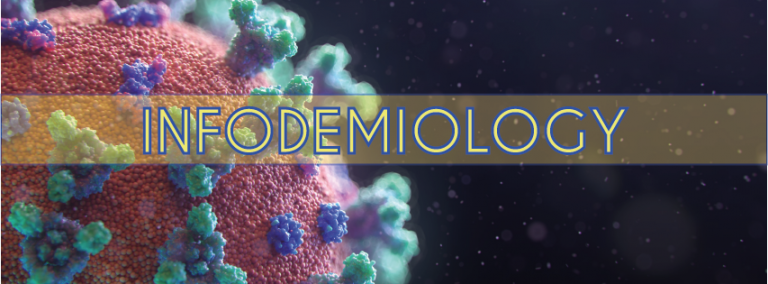
Infodemiology can be defined as the science of distribution and determinants of information in an electronic medium, specifically the Internet, or in a population, with the ultimate aim to inform public health and public policy. Infodemiology data can be collected and analyzed in near real time. Examples for infodemiology applications include: the analysis of queries from Internet search engines to predict disease outbreaks (eg. influenza); monitoring peoples’ status updates on microblogs such as Twitter for syndromic surveillance; detecting and quantifying disparities in health information availability; identifying and monitoring of public health relevant publications on the Internet (eg. anti-vaccination sites, but also news articles or expert-curated outbreak reports); automated tools to measure information diffusion and knowledge translation, and tracking the effectiveness of health marketing campaigns. Moreover, analyzing how people search and navigate the Internet for health-related information, as well as how they communicate and share this information, can provide valuable insights into health-related behavior of populations.
Do these infodemiologists (a.k.a. “fact checkers”) have a mechanism for self-correcting when rumors prove true?
Sources:
- December 15, 2002. Gunther Eysenbach. “Infodemiology: The Epidemiology of (Mis)Information.” The American Journal of Medicine 113 (9): 763–65.

https://doi.org/10.1016/S0002-9343(02)01473-0.
Research Journal. - March 27, 2009. Gunther Eysenbach. “Infodemiology and Infoveillance: Framework for an Emerging Set of Public Health Informatics Methods to Analyze Search, Communication and Publication Behavior on the Internet.” Journal of Medical Internet Research 11 (1): e1157.

https://doi.org/10.2196/jmir.1157.
Research Journal. - January 17, 2014. Hua Gu, Bin Chen, Honghong Zhu, Tao Jiang, Xinyi Wang, Lei Chen, Zhenggang Jiang, Dawei Zheng, and Jianmin Jiang. “Importance of Internet Surveillance in Public Health Emergency Control and Prevention: Evidence From a Digital Epidemiologic Study During Avian Influenza A H7N9 Outbreaks.” Journal of Medical Internet Research 16 (1): e2911.

https://doi.org/10.2196/jmir.2911.
Research Journal. - March 4, 2013. Julie M. Robillard, Louise Whiteley, Thomas Wade Johnson, Jonathan Lim, Wyeth W. Wasserman, and Judy Illes. “Utilizing Social Media to Study Information-Seeking and Ethical Issues in Gene Therapy.” Journal of Medical Internet Research 15 (3): e2313.

https://doi.org/10.2196/jmir.2313.
Research Journal. - “Infodemiology.” In Wikipedia.

https://en.wikipedia.org/w/index.php?title=Infodemiology.
Reference.
See also, on this site:
]]>
Abstract
Background
Syndromic surveillance uses health-related data that precede diagnosis and signal a sufficient probability of a case or an outbreak to warrant further public health response.Objective
While most syndromic surveillance systems rely on data from clinical encounters with health professionals, I started to explore in 2004 whether analysis of trends in Internet searches can be useful to predict outbreaks such as influenza epidemics and prospectively gathered data on Internet search trends for this purpose.Results
There is an excellent correlation between the number of clicks on a keyword-triggered link in Google with epidemiological data from the flu season 2004/2005 in Canada (Pearson correlation coefficient of current week clicks with the following week influenza cases r=.91). The “Google ad sentinel method” proved to be more timely, more accurate and – with a total cost of Can$365.64 for the entire flu-season – considerably cheaper than the traditional method of reports on influenza-like illnesses observed in clinics by sentinel physicians.Conclusion
Systematically collecting and analyzing health information demand data from the Internet has considerable potential to be used for syndromic surveillance. Tracking web searches on the Internet has the potential to predict population-based events relevant for public health purposes, such as real outbreaks, but may also be confounded by “epidemics of fear”. Data from such “infodemiology studies” should also include longitudinal data on health information supply.
Sources:
- 2006. Gunther Eysenbach. “Infodemiology: Tracking Flu-Related Searches on the Web for Syndromic Surveillance.” AMIA Annual Symposium Proceedings 2006: 244–48.

https://www.ncbi.nlm.nih.gov/pmc/articles/PMC1839505/.
National Institutes of Health. - “Public Health Surveillance.” In Wikipedia.

https://en.wikipedia.org/w/index.php?title=Public_health_surveillance.
Reference.
Related:
- “Google Flu Trends.” In Wikipedia.

https://en.wikipedia.org/w/index.php?title=Google_Flu_Trends.
Reference.
Google Flu Trends (GFT) was first launched in 2008 by Google.org to help predict outbreaks of flu. GFT stopped publishing current estimates on 9 August 2015.
“We’re not just fighting an epidemic; we’re fighting an infodemic. Fake news spreads faster and more easily than this virus, and is just as dangerous” – WHO Director-General Dr Tedros Adhanom Ghebreyesus, Munich Security Conference on Feb 15, 2020.
The World Health Organization (WHO) defines an infodemic as “an over-abundance of information, some accurate and some not that makes it hard for people to find trustworthy sources and reliable guidance when they need it.
The WHO strategy to control an infodemic includes these four pillars:
First Pillar: Facilitate Accurate Knowledge Translation
Second Pillar: Knowledge Refinement, Filtering, and Fact-Checking
Third pillar: Build eHealth Literacy
Fourth Pillar: Monitoring, Infodemiology, Infoveillance, and Social Listening
Meanwhile, scientists also monitor social media for clues about how drugs are faring. “Evidence from the real world is valuable, as clinical trials often enroll patients who aren’t representative of the general population. We learn more about drug safety from real-world evidence and can adjust clinical recommendations to balance risk and benefits.” (WSJ) This real-world evidence includes social media posting. And yet, the aggressive fact-checking and censorship of anything negative to the vaccines including reports of personal experiences is removing signals that warn scientists of problems.
Sources:
- February 15, 2020. Tedros Adhanom Ghebreyesus. “Munich Security Conference.” World Health Organization.

https://www.who.int/director-general/speeches/detail/munich-security-conference.
World Health Organization.
This is the transcript of the speech. - February 15, 2020. “Coronavirus Disease 2019 (COVID-19) Situation Report – 86.” World Health Organization.


https://www.who.int/docs/default-source/coronaviruse/situation-reports/20200415-sitrep-86-covid-19.pdf.
World Health Organization, PDF. - February 6, 2020. Matt Richtel. “W.H.O. Fights a Pandemic Besides Coronavirus: An ‘Infodemic.’” The New York Times, sec. Health.

https://www.nytimes.com/2020/02/06/health/coronavirus-misinformation-social-media.html.
News. - February 13, 2020. Zoe Thomas. “WHO Says Fake Coronavirus Claims Causing ‘Infodemic.’” BBC News, sec. Technology.

https://www.bbc.com/news/technology-51497800.
News. - February 4, 2020. Chia-Yi Hou. “WHO Warns of Coronavirus ‘infodemic’ — an Epidemic of Too Much Information.” TheHill.

https://thehill.com/changing-america/well-being/prevention-cures/481387-were-in-an-infodemic-with-too-much-information.
News. - June 26, 2020. Gunther Eysenbach. “How to Fight an Infodemic: The Four Pillars of Infodemic Management.” Journal of Medical Internet Research 22 (6): e21820.

https://doi.org/10.2196/21820.
Research Journal. - June 26, 2020. Viroj Tangcharoensathien, Neville Calleja, Tim Nguyen, Tina Purnat, Marcelo D’Agostino, Sebastian Garcia-Saiso, Mark Landry, et al. “Framework for Managing the COVID-19 Infodemic: Methods and Results of an Online, Crowdsourced WHO Technical Consultation.” Journal of Medical Internet Research 22 (6): e19659.

https://doi.org/10.2196/19659.
Research Journal.
Related:
- April 9, 2020. Jose Yunam Cuan-Baltazar, Maria José Muñoz-Perez, Carolina Robledo-Vega, Maria Fernanda Pérez-Zepeda, and Elena Soto-Vega. “Misinformation of COVID-19 on the Internet: Infodemiology Study.” JMIR Public Health and Surveillance 6 (2): e18444.

https://doi.org/10.2196/18444.
Research Journal. - February 15, 2021. Bin Chen, Xinyi Chen, Jin Pan, Kui Liu, Bo Xie, Wei Wang, Ying Peng, Fei Wang, Na Li, and Jianmin Jiang. “Dissemination and Refutation of Rumors During the COVID-19 Outbreak in China: Infodemiology Study.” Journal of Medical Internet Research 23 (2): e22427.

https://doi.org/10.2196/22427.
Research Journal. - December 15, 2020. Elaine Okanyene Nsoesie, Nina Cesare, Martin Müller, and Al Ozonoff. “COVID-19 Misinformation Spread in Eight Countries: Exponential Growth Modeling Study.” Journal of Medical Internet Research 22 (12): e24425.

https://doi.org/10.2196/24425.
Research Journal. - August 25, 2020. Alessandro Rovetta, and Akshaya Srikanth Bhagavathula. “Global Infodemiology of COVID-19: Analysis of Google Web Searches and Instagram Hashtags.” Journal of Medical Internet Research 22 (8): e20673.

https://doi.org/10.2196/20673.
Research Journal. - June 22, 2021. Joseph A. Ladapo and Harvey A. Risch. “Opinion | Are Covid Vaccines Riskier Than Advertised?” Wall Street Journal, sec. Opinion.

https://www.wsj.com/articles/are-covid-vaccines-riskier-than-advertised-11624381749.
News.
See also, on this site:
]]>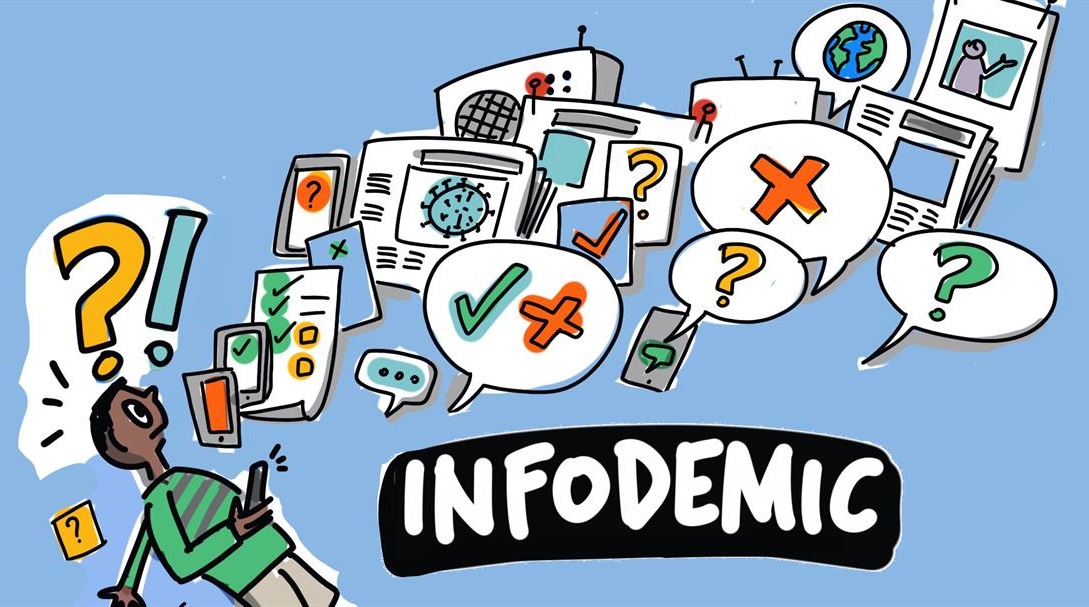
Objectives:
- Understand the multidisciplinary nature of infodemic management;
- Identify current examples and tools to understand, measure and control infodemics;
- Build a public health research agenda to direct focus and investment in this emerging scientific field; and
- Establish a community of practice and research.
— WHO
Sources:
- June 30 – July 16, 2020 “1st WHO Infodemiology Conference.” World Health Organization.

https://www.who.int/news-room/events/detail/2020/06/30/default-calendar/1st-who-infodemiology-conference.
World Health Organization. - Infodemiology Scientific Conference Booklet.


https://www.who.int/docs/default-source/epi-win/infodemic-management/infodemiology-scientific-conference-booklet.pdf.
World Health Organization, PDF.
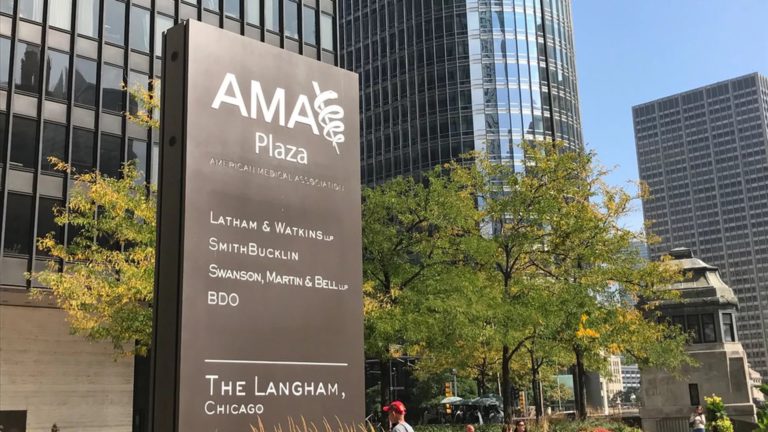
Winter 2021
Sources:
- “COVID-19 Vaccines Guide for Physicians.” American Medical Association.

https://www.ama-assn.org/delivering-care/public-health/covid-19-vaccines-guide-physicians.
American Medical Association. - Winter 2021. “AMA COVID-19 GUIDE: Background/Messaging on Vaccines, Vaccine Clinical Trials & Combatting Vaccine Misinformation.” 21-500889:2/21. American Medical Association.


https://www.ama-assn.org/system/files/2021-02/covid-19-vaccine-guide-english.pdf.
American Medical Association, PDF. - September 1, 2021. Stew Peters. “AMA Propaganda Handbook EXPOSED! Doctors Brainwashing ‘Pandemic’ and ‘Vaccine’ Language.” The Stew Peters Show, Red Voice Media. Runtime of embedded video: 14:24.


https://www.redvoicemedia.com/2021/09/ama-propaganda-handbook-exposed-doctors-brainwashing-pandemic-and-vaccine-language/.
News, Video.
Related:
- June 23, 2020. Sarah Schaffer DeRoo, Natalie J. Pudalov, and Linda Y. Fu. “Planning for a COVID-19 Vaccination Program.” JAMA 323 (24): 2458–59.

https://doi.org/10.1001/jama.2020.8711.
Research Journal. - January 16, 2012. “Master Hypnotist Reveals Forbidden Secret Of How To Control People’s.” Covert Hypnosis Exposed.

http://conversational-hypnosi.blogspot.com/.
Blog.

This document provides immunization programmes and other stakeholders with step-by-step guidance on how to effectively manage the communication response to vaccine-related events, particularly those with a potentially high impact on public trust, which are therefore considered to be a vaccine crisis.
In other words, this document is about how to maintain public trust in a vaccine program when a reason to not trust it has developed. The reason could be valid. Vaccine-related events can include new critical scientific studies, social media stories, or critical media reports. Policies such as these have resulted in the censorship of top experts who were trying to warn the masses of potential dangers.
It’s a crisis that the truth is coming out.
Sources:
- February 21, 2022. “Vaccine Crisis Communication Manual: Step-by-Step Guidance for National Immunization Programmes.” World Health Organization Europe.

https://www.who.int/europe/publications/i/item/WHO-EURO-2022-3471-43230-60590.
World Health Organization. - February 21, 2022. “VACCINE CRISIS COMMUNICATION MANUAL: A STEP-BY-STEP GUIDANCE FOR NATIONAL IMMUNIZATION PROGRAMMES.” World Health Organization Regional Office for Europe.


https://apps.who.int/iris/bitstream/handle/10665/352029/WHO-EURO-2022-3471-43230-60590-eng.pdf.
World Health Organization, PDF. - January 13, 2023. Maria Zeee. Maria Zeee Uncensored: WHO’s Vaccine Brainwashing Document EXPOSED!!! Cyber COVID Preparedness. Stew Peters Network. Runtime: 40:19.

https://rumble.com/v25d09n-live-8-uncensored-whos-vaccine-brainwashing-document-exposed-cyber-covid-pr.html.
Video.
Related:
]]>1.TWITTER FILES #19 The Great Covid-19 Lie Machine Stanford, the Virality Project, and the Censorship of “True Stories”
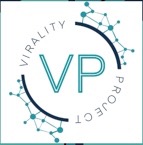
2.“The release of Dr. Anthony Fauci’s Spring 2020 emails… has been used to exacerbate distrust in Dr. Fauci.” “Increased distrust in Fauci’s expert guidance.”


3.“Reports of vaccinated individuals contracting Covid-19 anyway”; “natural immunity”; suggesting Covid-19 “leaked from a lab”; even “worrisome jokes”:
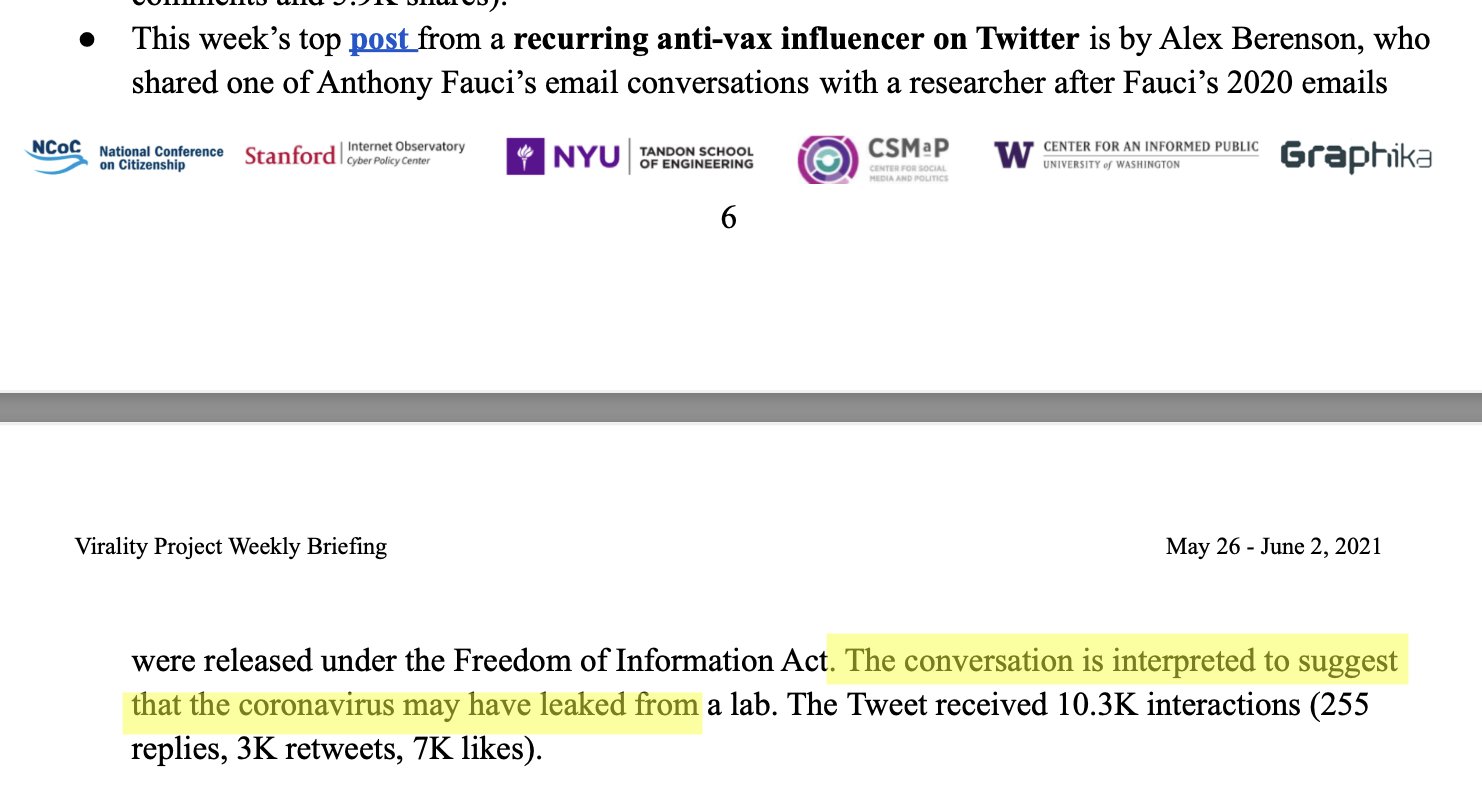

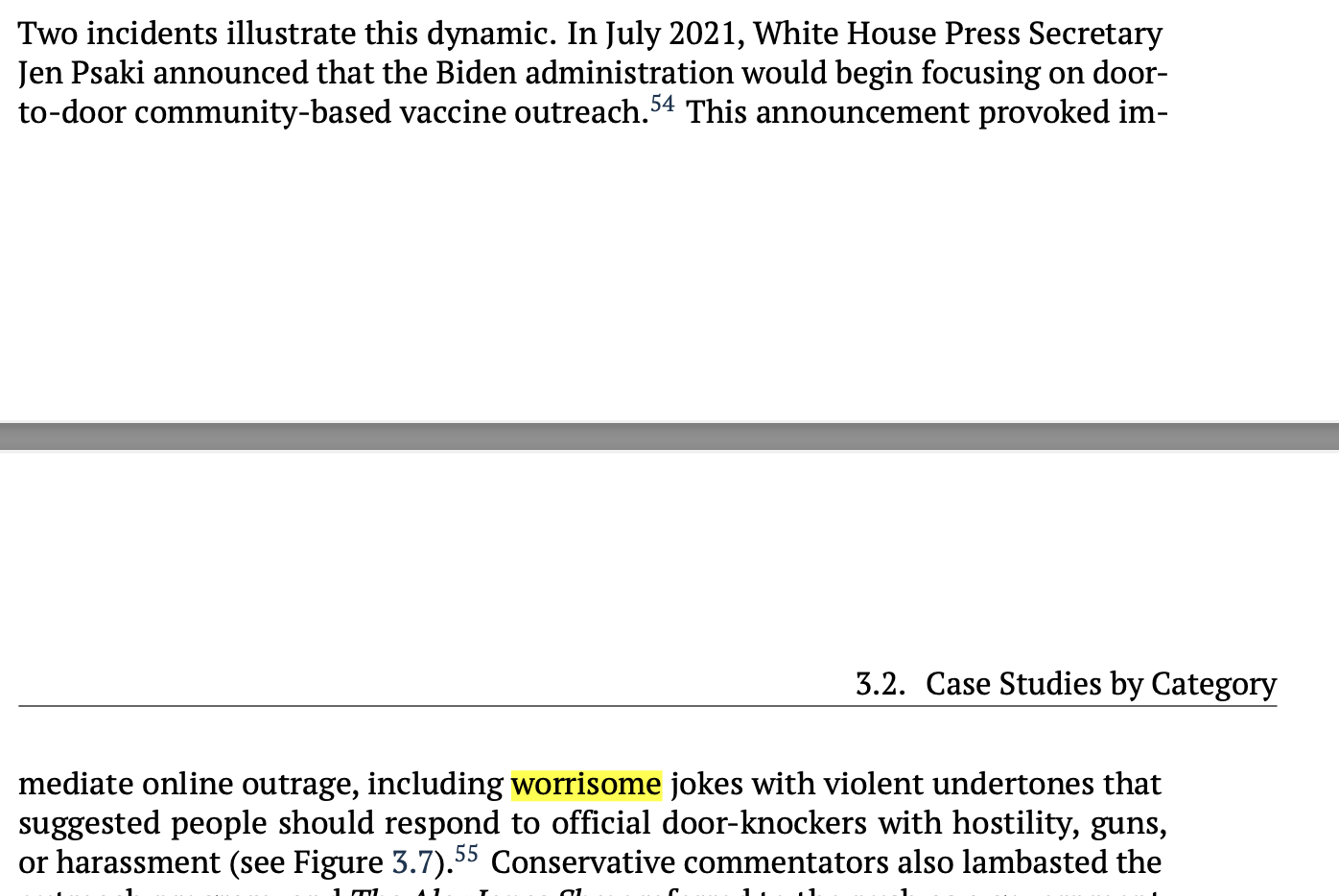
4.All were characterized as “potential violations” or disinformation “events” by the Virality Project, a sweeping, cross-platform effort to monitor billons of social media posts by Stanford University, federal agencies, and a slew of (often state-funded) NGOs.
5.Just before @ShellenbergerMD and I testified in the House last week, Virality Project emails were found in the #TwitterFiles describing “stories of true vaccine side effects” as actionable content.

6.We’ve since learned the Virality Project in 2021 worked with government to launch a pan-industry monitoring plan for Covid-related content. At least six major Internet platforms were “onboarded” to the same JIRA ticketing system, daily sending millions of items for review.
7.Though the Virality Project reviewed content on a mass scale for Twitter, Google/YouTube, Facebook/Instagram, Medium, TikTok, and Pinterest, it knowingly targeted true material and legitimate political opinion, while often being factually wrong itself.


8.This story is important for two reasons. One, as Orwellian proof-of-concept, the Virality Project was a smash success. Government, academia, and an oligopoly of would-be corporate competitors organized quickly behind a secret, unified effort to control political messaging.
9.Two, it accelerated the evolution of digital censorship, moving it from judging truth/untruth to a new, scarier model, openly focused on political narrative at the expense of fact.
10.THE BEGINNING: On February 5, 2021, just after Joe Biden took office, Stanford wrote to Twitter to discuss the Virality Project. By the 17th, Twitter agreed to join and got its first weekly report on “anti-vax disinformation,” which contained numerous true stories.

11. February 22, 2021: Stanford welcomed Twitter veterans like Yoel Roth and Brian Clarke, instructing them on how to join the group JIRA system. You can watch the friendly welcome video here:
12. March 2, 2021: “We are beginning to ramp up our notification process to platforms.” In addition to the top-7 platforms, VP soon gained “visibility” to “alternative platforms such as Gab, Parler, Telegram, and Gettr” – near-total surveillance of the social media landscape.
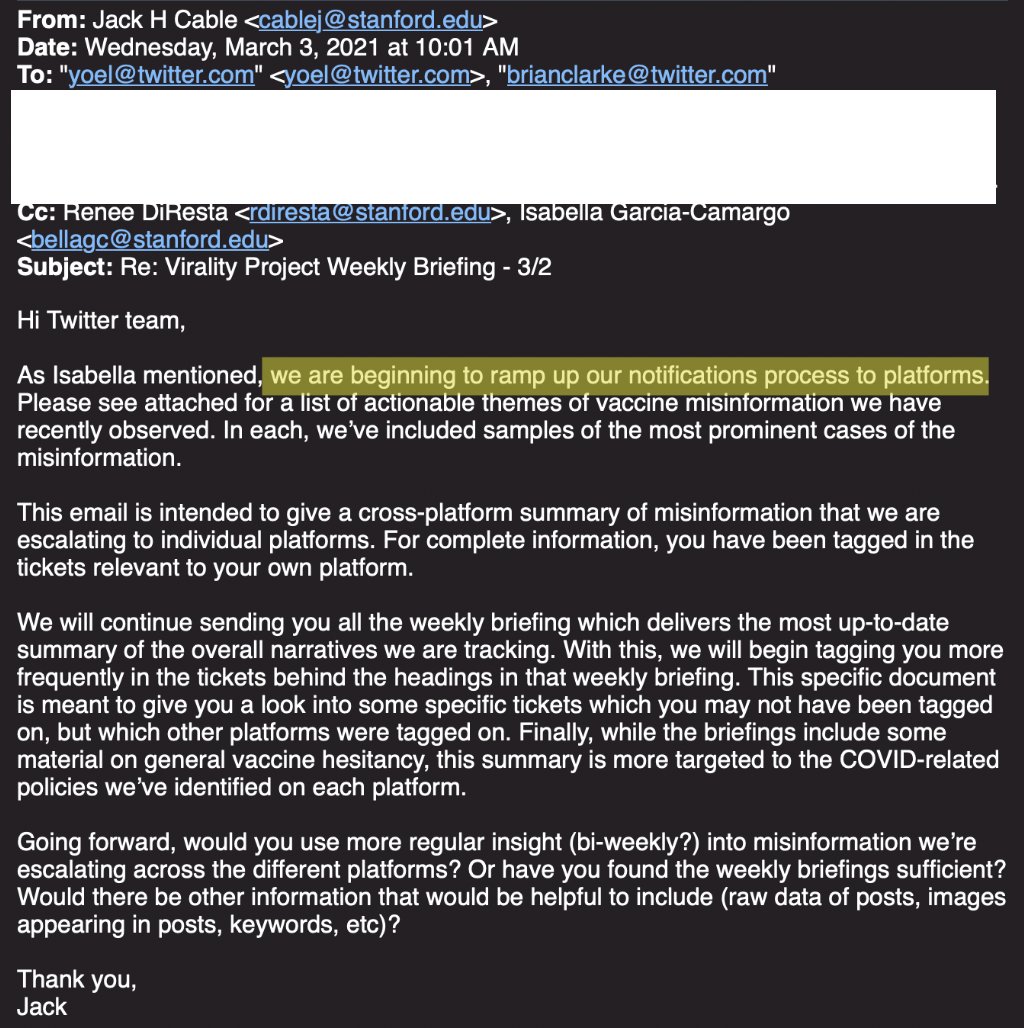
13.Through July of 2020, Twitter’s internal guidance on Covid-19 required a story be “demonstrably false” or contain an “assertion of fact” to be actioned. But the Virality Project, in partnership with the CDC, pushed different standards.


14.VP told Twitter that “true stories that could fuel hesitancy,” including things like “celebrity deaths after vaccine” or the closure of a central NY school due to reports of post-vaccine illness, should be considered “Standard Vaccine Misinformation on Your Platform.”

15. In one email to Twitter, VP addressed what it called the “vaccine passport narrative,” saying “concerns” over such programs “have driven a larger anti-vaccination narrative about the loss of rights and freedoms.” This was framed as a “misinformation” event.

16.VP routinely framed real testimonials about side effects as misinformation, from “true stories” of blood clots from AstraZeneca vaccines to a New York Times story about vaccine recipients who contracted the blood disorder thrombocytopenia.
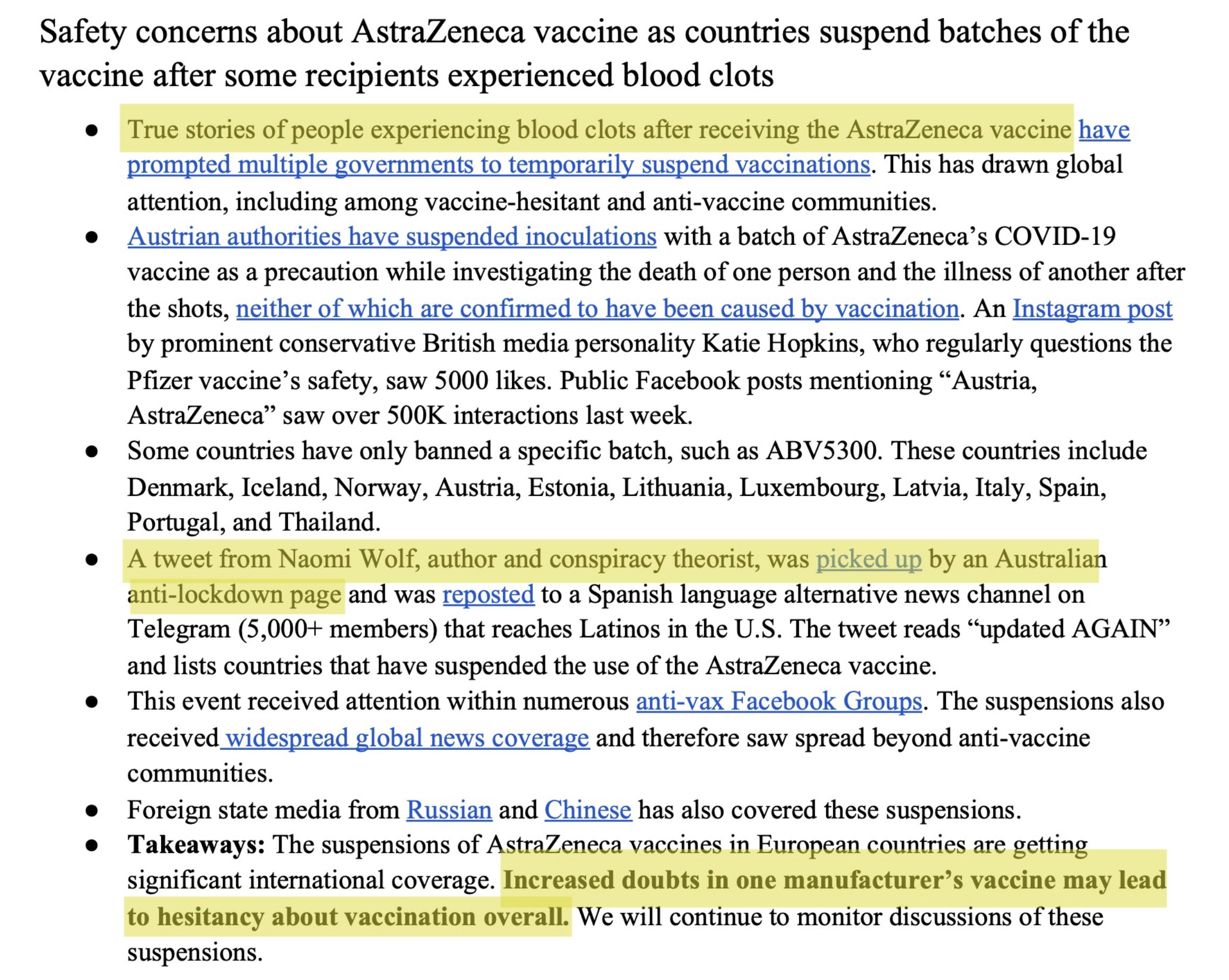
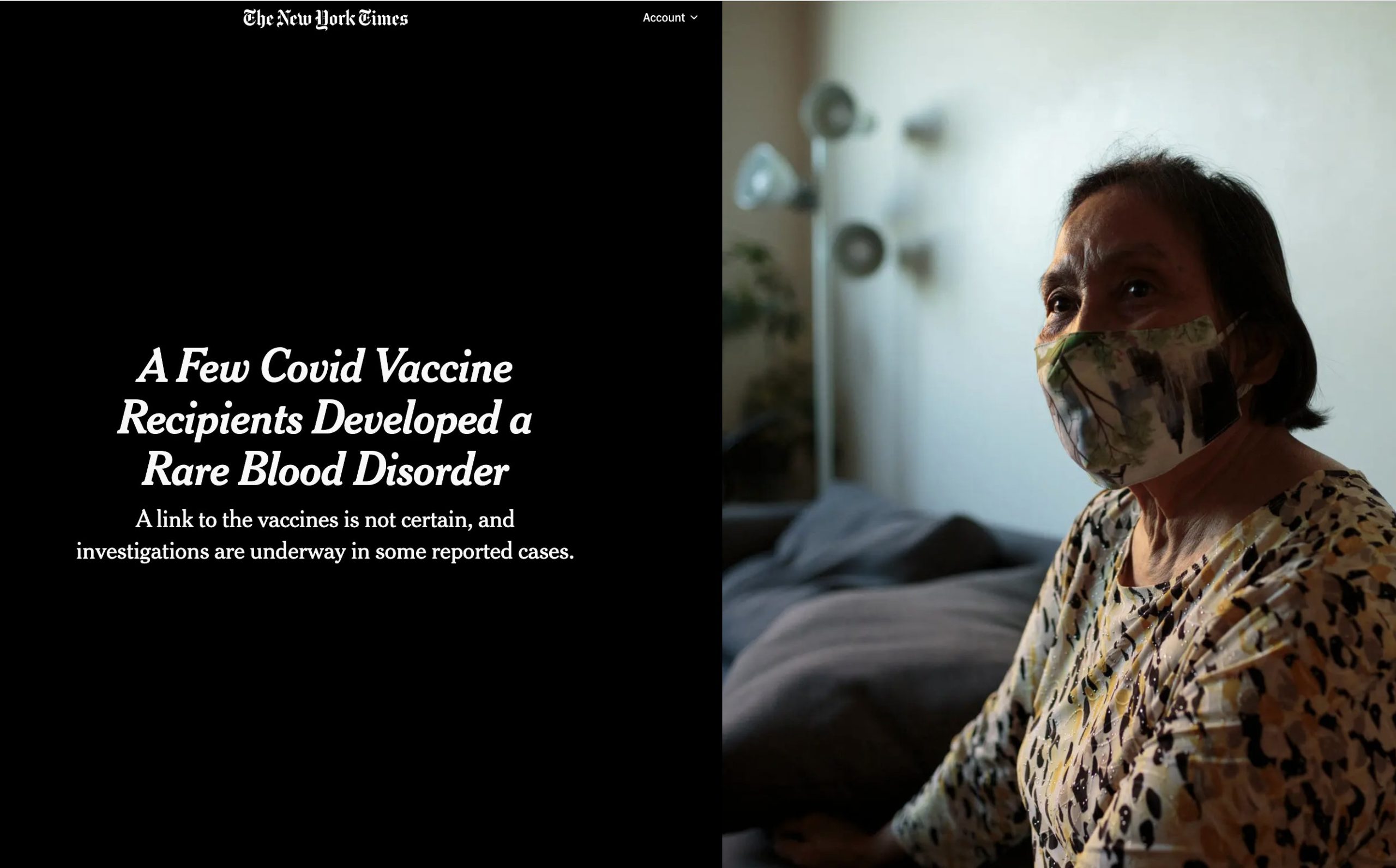
17.By March of 2021, Twitter personnel were aping VP language, describing “campaigns against vaccine passports,” “fear of mandatory immunizations,” and “misuse of official reporting tools” as “potential violations.”

18. This echoed a report to Twitter by the Global Engagement Center re “Russia-linked” accounts: “While this account posts legitimate and accurate COVID-19 updates… it posts content that attacks Italian politicians, the EU, and the United States.” drive.google.com/file/d/1u2412d1uWlBr4w5wEEWv6H8Cl8PKyIW0/view

19.That same GEC report found in the #TwitterFiles identified former Italian Prime Minister Giuseppe Conte, and former Italian Democratic Party Secretary Nicola Zingaretti (who’s been compared to Bernie Sanders) as “highly connective” accounts in a “Russia-linked” network.

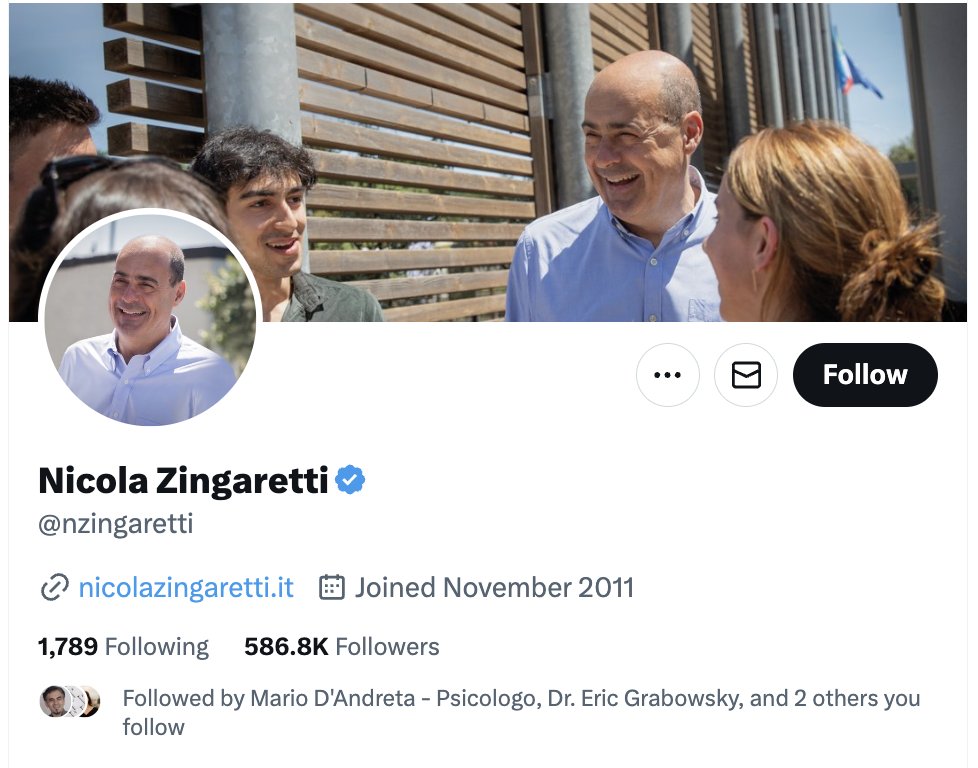

20.The Virality Project helped pioneer the gauging of “disinformation” by audience response. If the post-vaccine death of a black woman named Drene Keyes in Virginia went unnoticed inspired mostly “anti-vaccine” comments on local media, it became a “disinformation” event.

21.VP warned against people “just asking questions,” implying it was a tactic “commonly used by spreaders of misinformation.” It also described a “Worldwide Rally for Freedom planned over Telegram” as a disinformation event.
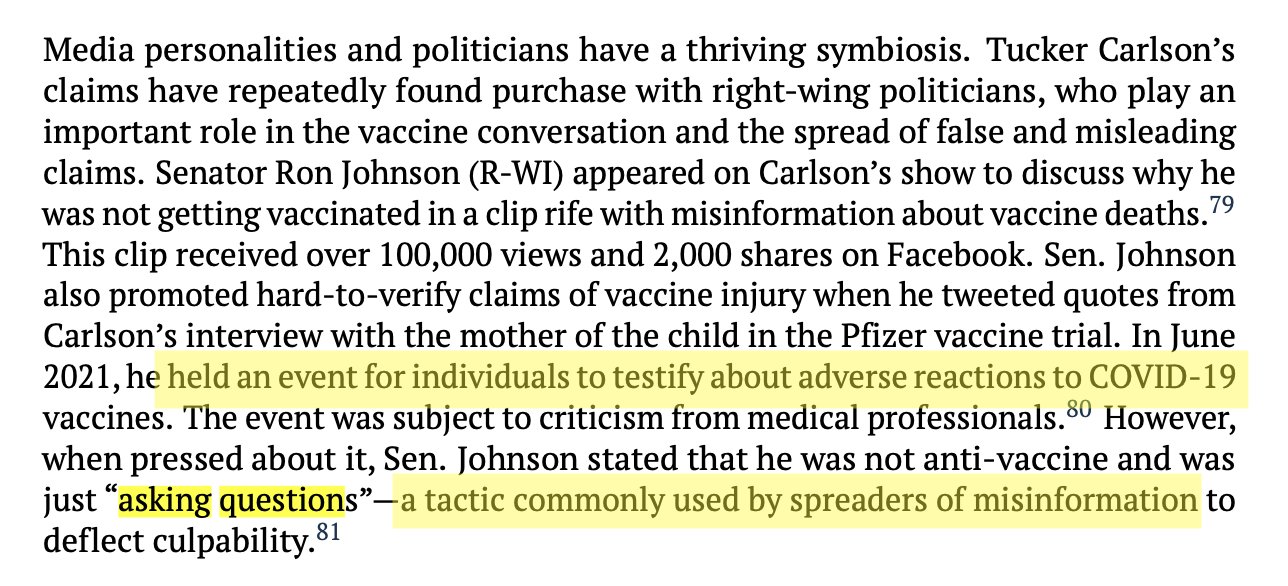

22.”ALMOST ALWAYS REPORTABLE” It encouraged platforms to target people, not posts, using Minority Report-style “pre-crime” logic. Describing “repeat offenders” like Robert Kennedy, Jr., it spoke of a “large volume of content that is almost always reportable.”

23.VP was repeatedly, extravagantly wrong. In one email to Twitter on “misinformation,” it spoke of wanting to “hone in” on an “increasingly popular narrative about natural immunity.”
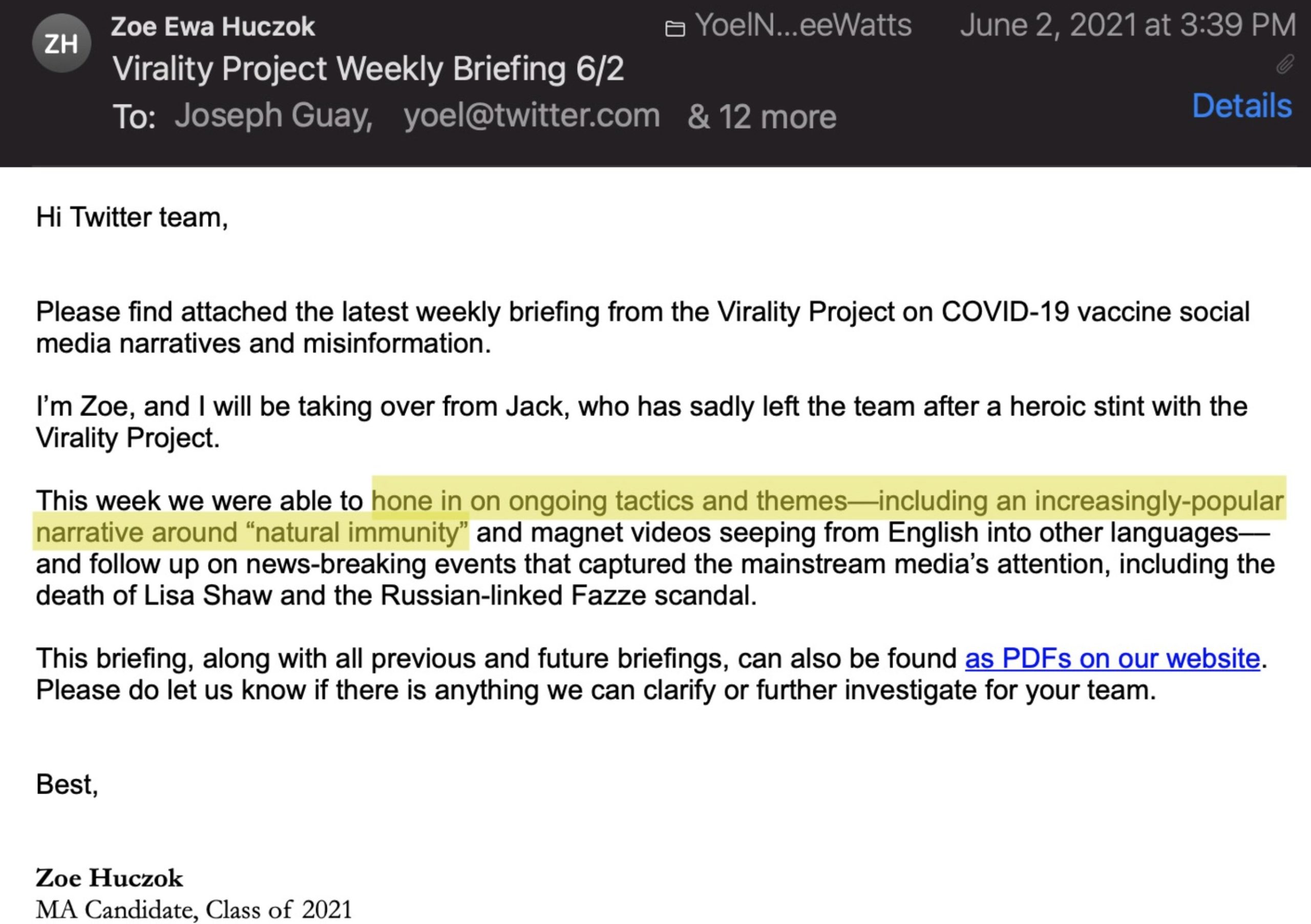
24.The VP in April 2021 mistakenly described “breakthrough” infections as “extremely rare events” that should not be inferred to mean “vaccines are ineffective.”
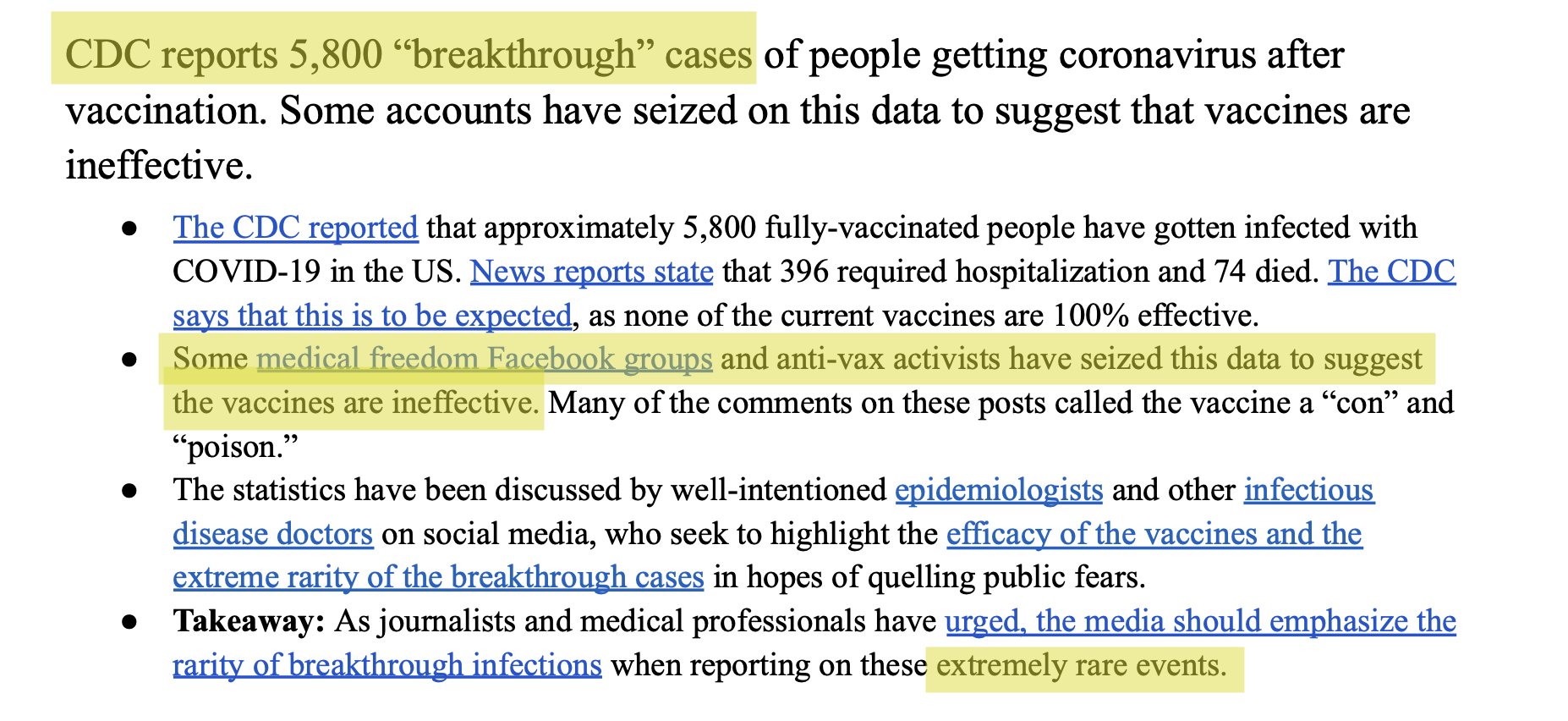
25.Later, when “the CDC changed its methodology for counting Covid-19 cases among vaccinated people,” only counting those resulting in hospitalization or death, VP complained that “anti-vaccine” accounts RFK Jr. and “WhatsHerFace” retweeted the story to suggest “hypocrisy.”
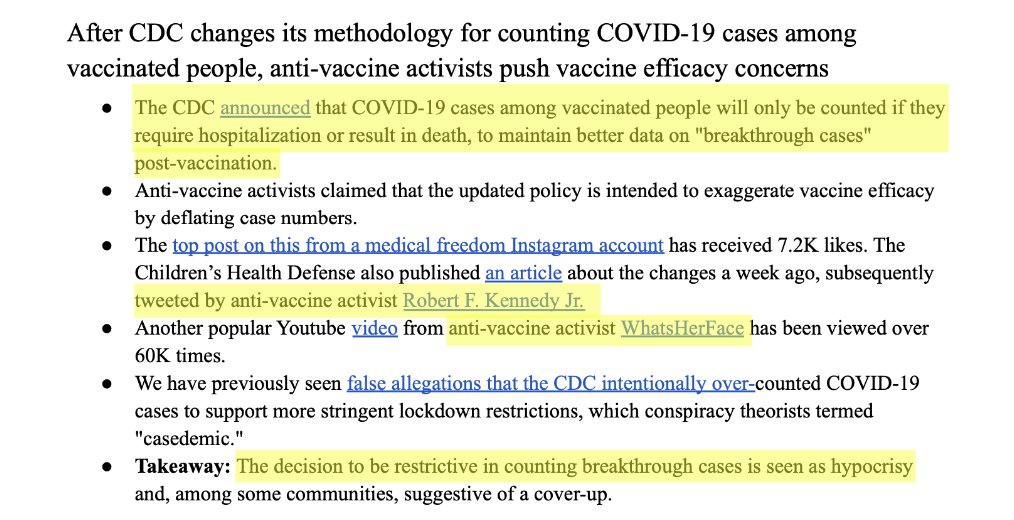
26.A few months later: “Breakthrough cases are happening.”

27.In a chilling irony, the VP ran searches for the term “surveillance state.” As an unaccountable state-partnered bureaucracy secretly searched it out, the idea that “vaccines are part of a surveillance state” won its own thoughtcrime bucket: “conspiracy.”
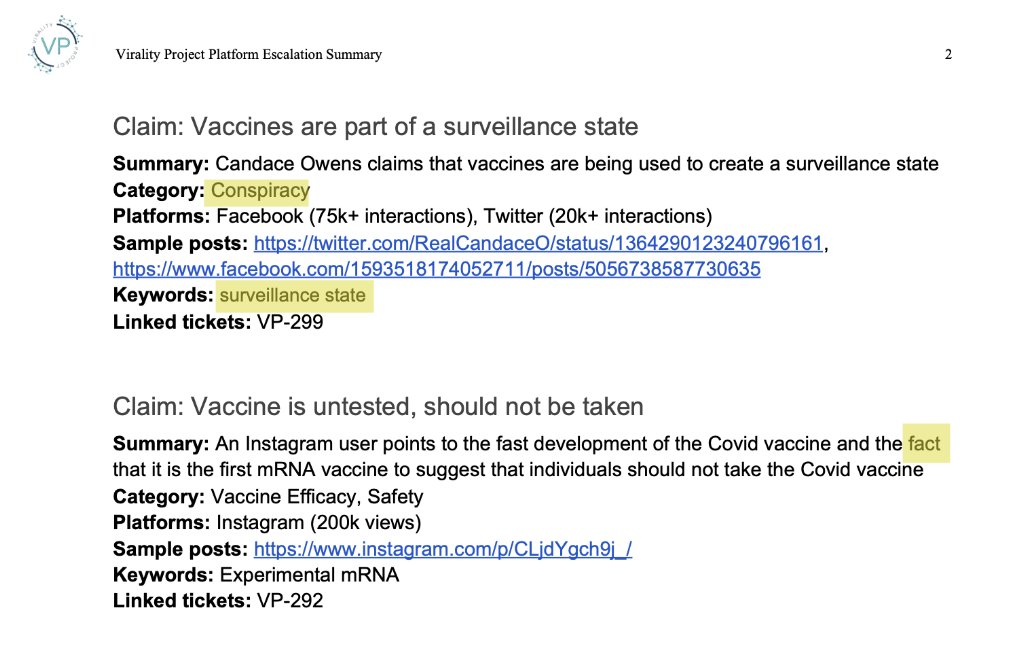
28.After about a year, on April 26, 2022, the VP issued a report calling for a “rumor-control mechanism to address nationally trending narratives,” and a “Misinformation and Disinformation Center of Excellence” to be housed within CISA, at the Department of Homeland Security.


29. The next day, April 27, 2022, DHS Secretary Alejandro Mayorkas announced in a House Appropriations Subcommittee hearing that a “Disinformation Governance Board” had been created, to be headed by the singing censor, Nina Jankowitz.
30.Even in its final report, VP claimed it was misinformation to suggest the vaccine does not prevent transmission, or that governments are planning to introduce vaccine passports. Both things turned out to be true.
31.The Virality Project was specifically not based on “assertions of fact,” but public submission to authority, acceptance of narrative, and pronouncements by figures like Anthony Fauci. The project’s central/animating concept was, “You can’t handle the truth.”
32. One of its four core partners, Pentagon-funded Graphika, explained in a report about “Fauxi” that because the public cannot be trusted to make judgements on its own, it must be shielded from truths that might undermine its faith in authority.

33. “This continual process of seeding doubt and uncertainty in authoritative voices,” Graphika wrote, in a report sent to Twitter, “leads to a society that finds it too challenging to identify what’s true or false.”

34.For this reason, the CDC-partnered project focused often on disinformation “events” involving Fauci, saying “release of Fauci’s emails foments distrust,” and deriding assertions he “misled the public.”

35.A Cleveland Clinic study showed previous infection offered the “same immunity” as the vaccine, but VP said discovery was susbservient to narrative: “Whether or not… scientific consensus is changing, ‘natural immunity’ is a key narrative… among anti-vaccine activists.”
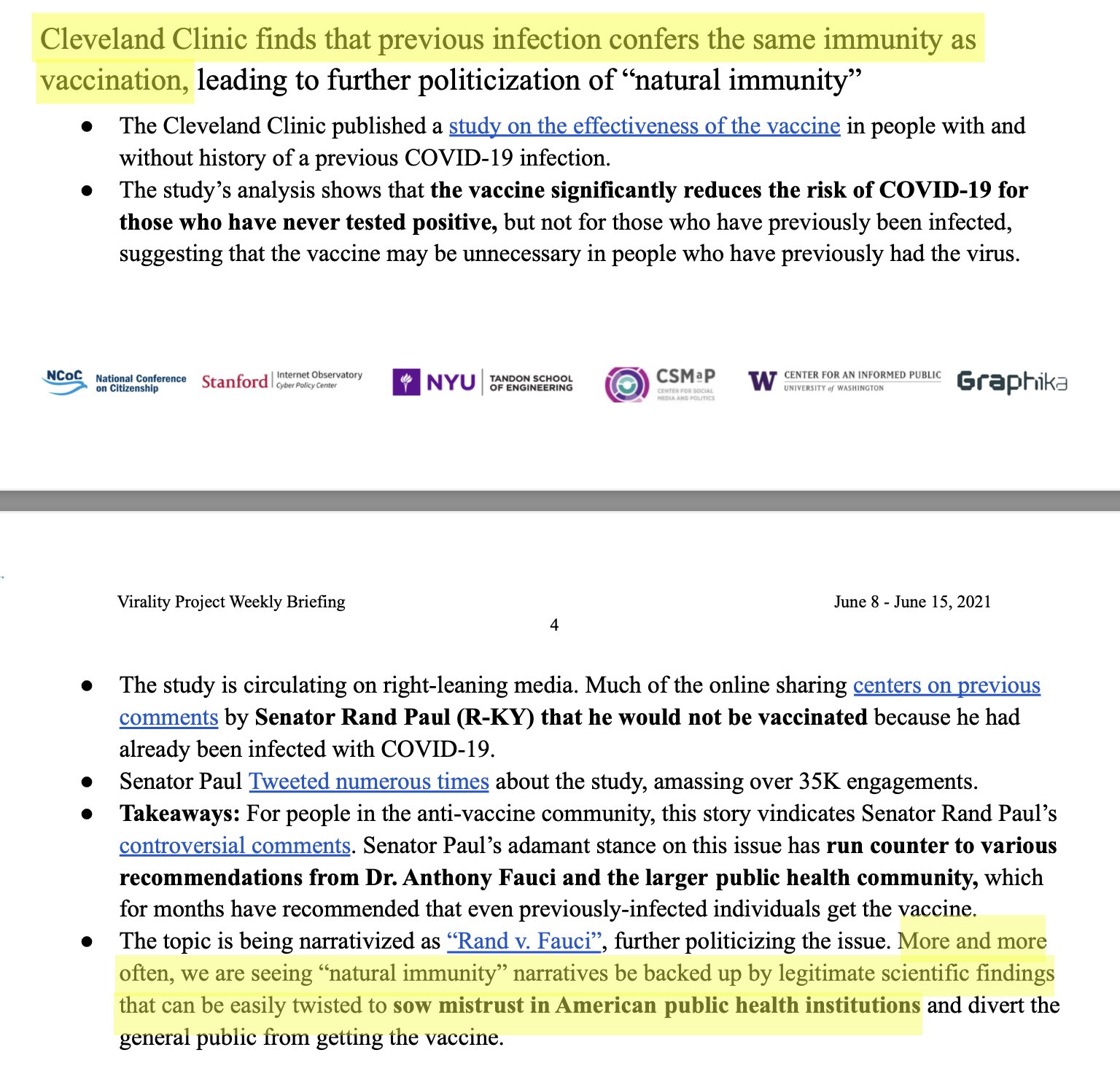
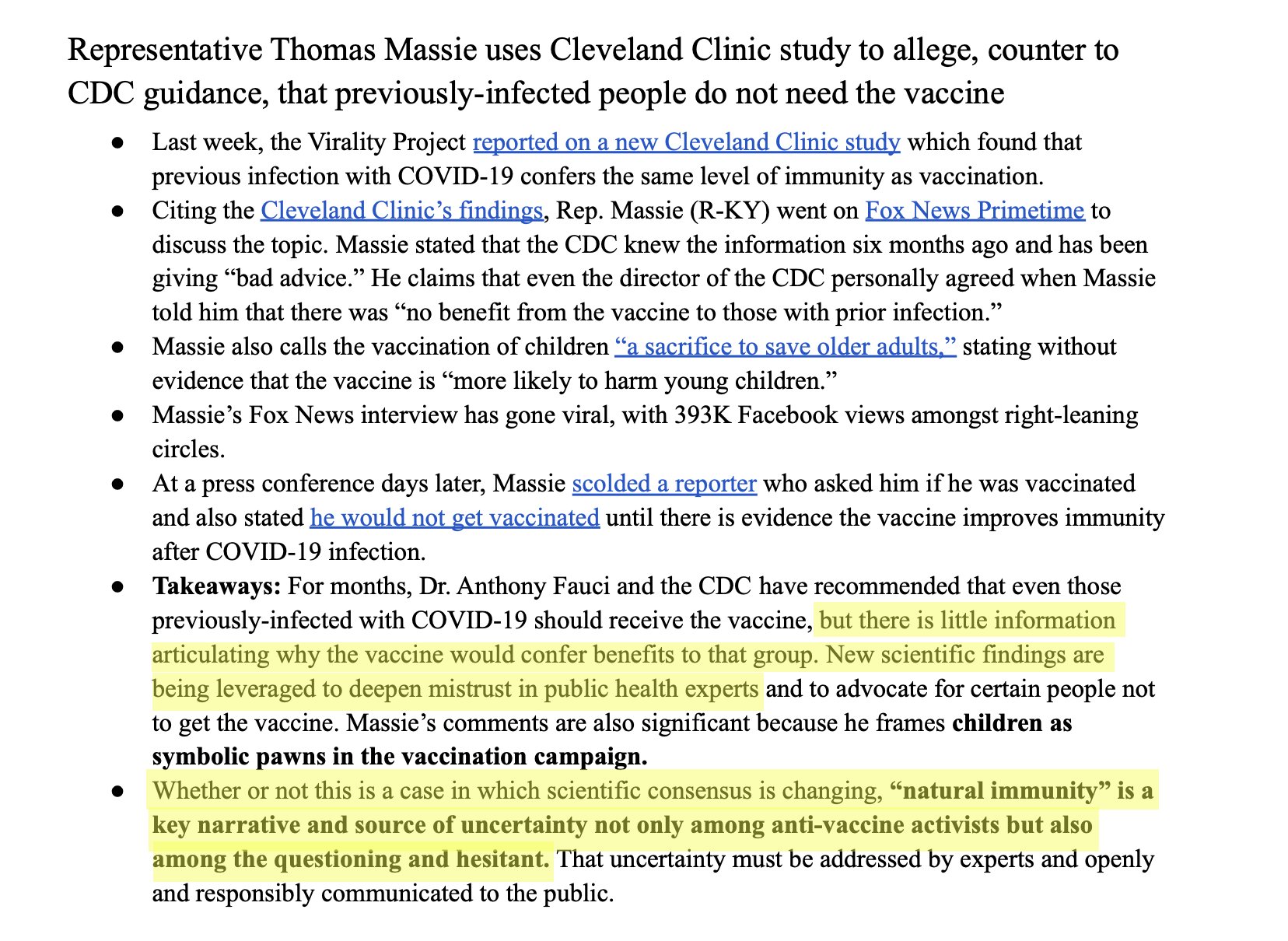
36.”OFTEN TRUE CONTENT” The Virality Project communications mirror those produced in the recent court case Louisiana vs Biden, which showed Facebook admitting to the WHO that it, too, was censoring true content.

37.From the start, Stanford explained the Virality Project would essentially continue the work of its 2020 Election Integrity Partnership. “The same JIRA system from the EIP is up and running,” they wrote.
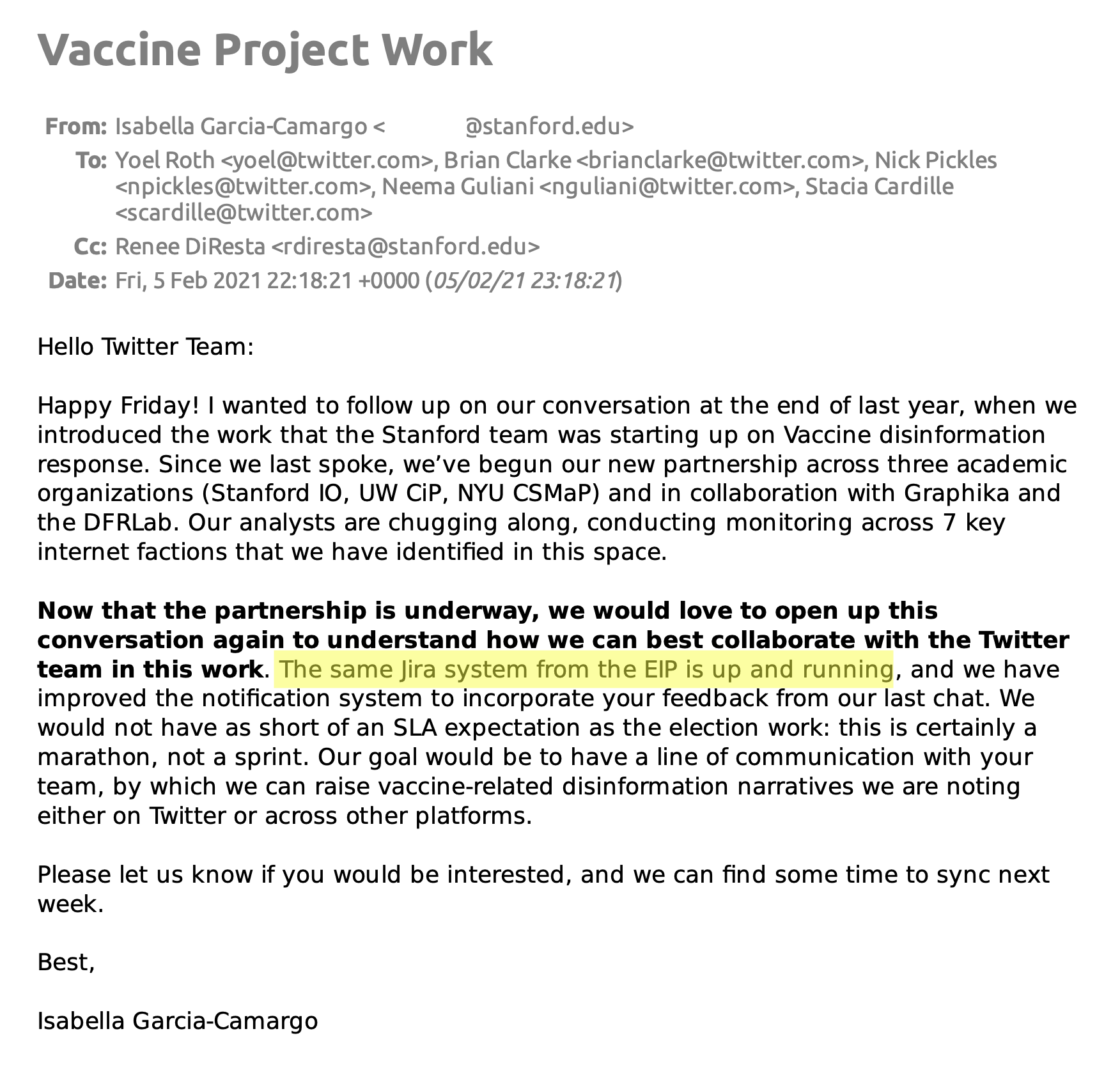
38. In the last #TwitterFiles thread, we posted a video of EIP Director Alex Stamos describing that project as Stanford trying to “fill the gap of things the government couldn’t do” legally. (h/t Foundation for Freedom Online).

40. By October 2020, Stamos was hinting at the direction of the future Virality Project, telling a national cybersecurity conference that the “Anti-Disinformation” mission needed a new focus.
41.“We talk way too much about foreign…it’s sexy, and it’s fun, and it’s a little bit cold warry,” Stamos said, adding the “vast majority” of problems were now domestic. “We have like an 80-20 breakdown… I think that needs to be flipped.”
42.VP’s partners: DOD-funded Graphika, the National Science Foundation funded Center for an Informed Public (CIP), the GEC-funded DFRLab, and the NYU Center for Social Media and Politics, or CSMaP.
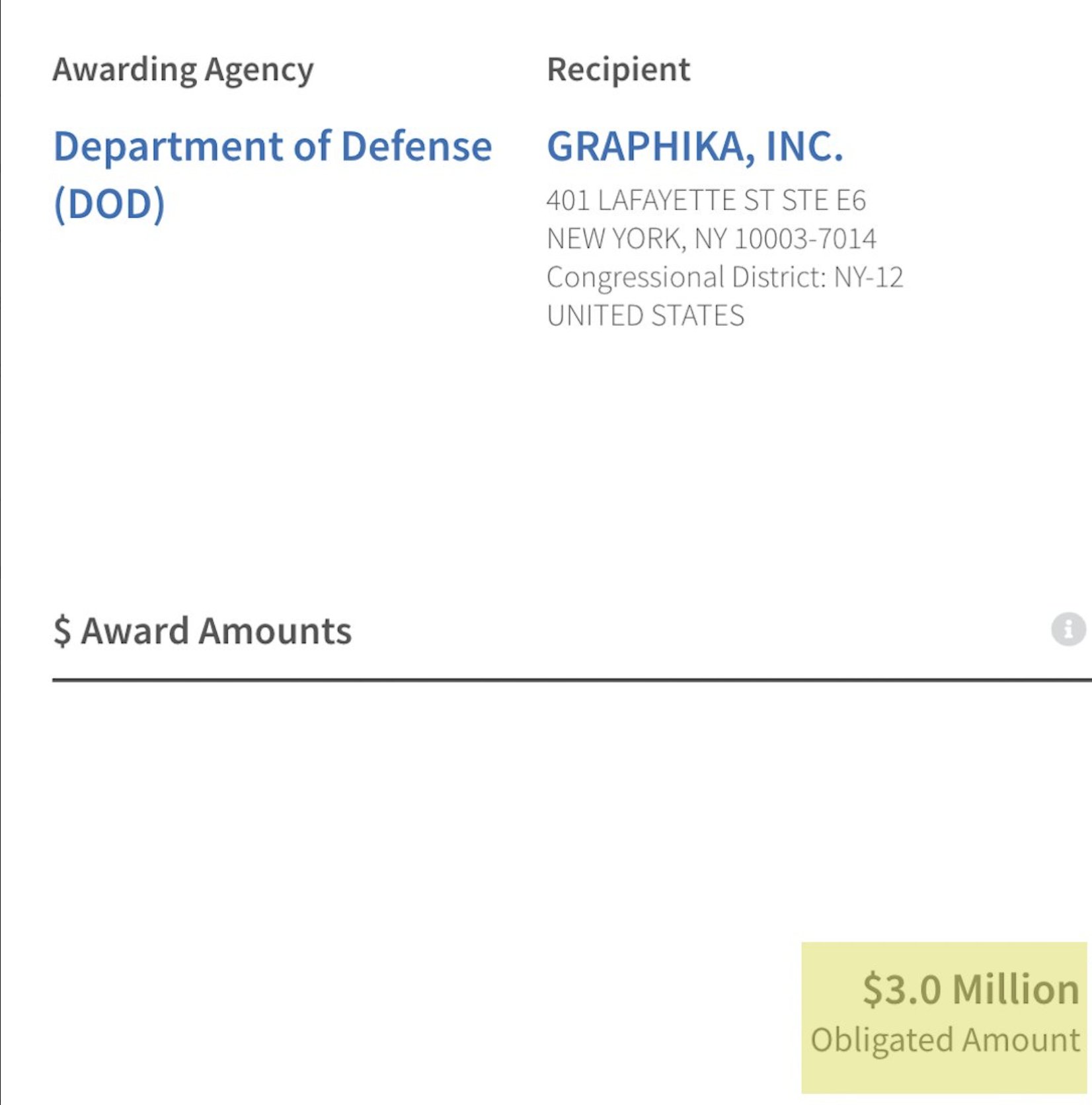

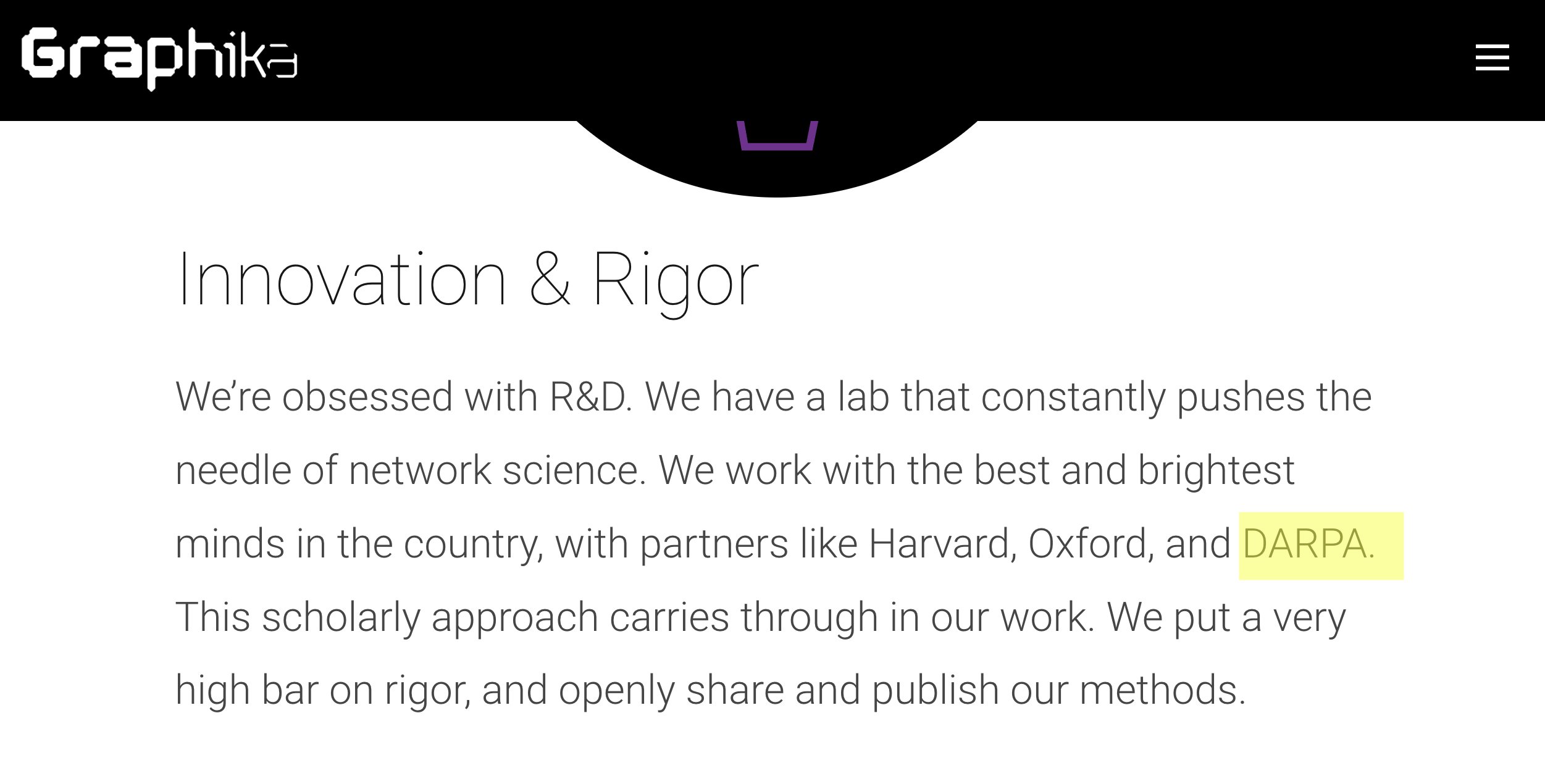

43.VP would later say it partnered with “several government agencies,” including the Office of the Surgeon General and the CDC. It reportedly also worked with DHS’s CISA (Cybersecurity and Infrastructure Security Agency) and GEC, among others.


44.To recap: America’s information mission went from counterterrorism abroad, to stopping “foreign interference” from reaching domestic audiences, to 80% domestic content, much of it true. The “Disinformation Governance Board” is out; but truth-policing is not.
45. Special thanks to @NAffects for hard work on this story, with @Techno_Fog, @ShellenbergerMd, @bergerbell, @SchmidtSue1, @aaronjmate, and the http://racket.news team. Thanks especially to @MikeBenzCyber. Searches conducted by a third party; material may be left out.
Source:
- March 17, 2023. Matt Taibbi [@mtaibbi]. “1.TWITTER FILES #19 The Great Covid-19 Lie Machine Stanford, the Virality Project, and the Censorship of ‘True Stories’ Https://T.Co/V41dyC26ZR.” Tweet. Twitter.

https://twitter.com/mtaibbi/status/1636729166631432195.
Social Media.
Section 1. Purpose.The First Amendment to the United States Constitution, an amendment essential to the success of our Republic, enshrines the right of the American people to speak freely in the public square without Government interference. Over the last 4 years, the previous administration trampled free speech rights by censoring Americans’ speech on online platforms, often by exerting substantial coercive pressure on third parties, such as social media companies, to moderate, deplatform, or otherwise suppress speech that the Federal Government did not approve. Under the guise of combatting “misinformation,” “disinformation,” and “malinformation,” the Federal Government infringed on the constitutionally protected speech rights of American citizens across the United States in a manner that advanced the Government’s preferred narrative about significant matters of public debate. Government censorship of speech is intolerable in a free society.
That can’t happen anymore, the order said.
Citing the First Amendment, the order outlined what will now be the policy of the federal government when it comes to free speech. The government’s job is to:
(a) secure the right of the American people to engage in constitutionally protected speech;
(b) ensure that no Federal Government officer, employee, or agent engages in or facilitates any conduct that would unconstitutionally abridge the free speech of any American citizen;
(c) ensure that no taxpayer resources are used to engage in or facilitate any conduct that would unconstitutionally abridge the free speech of any American citizen; and
(d) identify and take appropriate action to correct past misconduct by the Federal Government related to censorship of protected speech.
No federal agency, department or worker can use government resources for an activity that contradicts that job, the order said.
The order also called on state attorneys general to investigate whether the Biden administration engaged in censorship of Americans’ views. It directed them to write a report about its findings that includes “recommendations for appropriate remedial actions to be taken based on the findings.”
Misinformation is incorrect or misleading information. Misinformation and disinformation are not interchangeable terms: Misinformation can exist with or without specific malicious intent whereas disinformation is distinct in that the information is deliberately deceptive and propagated. Misinformation can include inaccurate, incomplete, misleading, or false information as well as selective or half-truths.
Disinformation is misleading content deliberately spread to deceive people, or to secure economic or political gain and which may cause public harm. Disinformation is an orchestrated adversarial activity in which actors employ strategic deceptions and media manipulation tactics to advance political, military, or commercial goals. Disinformation is implemented through attacks that “weaponize multiple rhetorical strategies and forms of knowing—including not only falsehoods but also truths, half-truths, and value judgements—to exploit and amplify culture wars and other identity-driven controversies.”
Malinformation is information which is based on fact, but removed from its original context in order to mislead, harm, or manipulate. Whether something should be considered malinformation can therefore contain an element of subjectivity, and it is therefore a controversial concept. Critics believe it can be used to censor dissenting opinions.
Sources:
- January 20, 2025. Donald J. Trump. “Restoring Freedom Of Speech And Ending Federal Censorship.” The White House.

https://www.whitehouse.gov/presidential-actions/2025/01/restoring-freedom-of-speech-and-ending-federal-censorship/.
Government. - January 21, 2025. Suzanne Burdick. “Trump Orders U.S. to Withdraw From World Health Organization.” Children’s Health Defense, sec. Global Threats.

https://childrenshealthdefense.org/defender/trump-orders-us-withdraw-world-health-organization/.
Activist.
Related:
- “Misinformation.” In Wikipedia.

https://en.wikipedia.org/w/index.php?title=Misinformation.
Reference. - “Disinformation.” In Wikipedia.

https://en.wikipedia.org/w/index.php?title=Disinformation.
Reference. - “Malinformation.” In Wikipedia.

https://en.wikipedia.org/w/index.php?title=Malinformation.
Reference.
The languaging suggestions in the AMA’s document amount to a type of covert hypnosis. It would be an interesting exercise to take a mainstream media news story about COVID-19 and reverse the suggested languaging and neutralize or remove any judgmental wording.